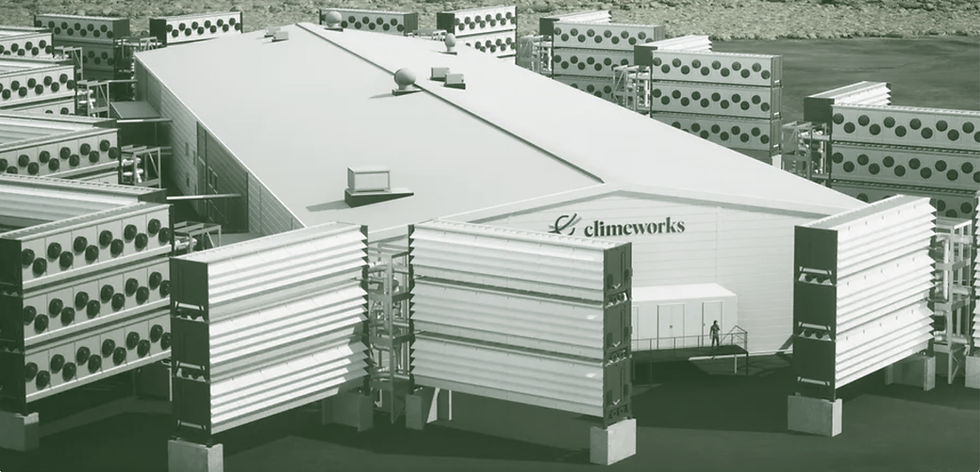Billions of dollars are coming for carbon capture projects, but they're not all created equally
- Jon Shieber
- Oct 28, 2022
- 6 min read

The I-10 interstate corridor that passes through Mobile, Alabama, New Orleans and Baton Rouge, Louisiana and on past Houston, Texas is one of the major arteries of the petrochemical industry.
Chemical companies from dozens of countries have plants along the interstate and oil companies including Exxon, Chevron, Occidental Petroleum, Saudi Aramco and others all have refineries dotting the Gulf Coast off of the highway.
It's along this stretch of land that the U.S.-based oil industry hopes to build out massive underground infrastructure to capture emissions from its operations and store them underground.
The projects involve capturing carbon dioxide from the production and refining work that these companies do and pumping those emissions into underground wells that can (ideally) permanently store the greenhouse gases released from their operations.
Emissions from these oil companies -- and the fossil fuel-powered engines, generators, and turbines that depend on them are warming the world, according to the latest scientific research. This global warming is making storms more powerful, causing unprecedented droughts around the world, and leading to the premature deaths of hundreds of thousands of people around the world.

Nearly 4,000 miles and half an ocean away on an industrial site just outside of Reykjavik in Iceland another type of carbon management project is already underway.
At the Orca facility built by the direct air capture company, Climeworks, massive fans are sucking air out of the atmosphere and filtering it to remove carbon dioxide.
The CO2 being captured isn't tied to any one source, unlike the carbon dioxide coming from refineries in Houston, but rather is tied to historical emissions already in the ambient air. And the company's unstated goals are a bit different.
Rather than allow the continuing use of fossil fuels, direct air capture companies like Climeworks (and a whole host of others backed by buyers like like Frontier Climate and venture capital investors like Lowercarbon Capital and Breakthrough Energy Ventures) are trying to remove the emissions that have already been emitted into the atmosphere.
"90% of getting to net zero is through reduction. and as we have already emitted too much as I'm speaking there's a part that has to be removed from the atmosphere and that is the 10%," said Dr. Christoph Gebald, the co-founder and chief executive of Climeworks, speaking at the SOSV ClimateTech Summit.
"That's the role we are playing at the moment as a small industry," Gebald said. "Put that in numbers, that's about 12 to 15 gigatons that needs to be removed from the atmosphere year-on-year."
"We as humans we emit CO2 into the atmosphere, but we're simply not taking it back. So we don't have a closed carbon cycle," said Gebald.
Gebald's work, and the work of dozens of companies working on carbon dioxide removal, or CDR projects -- are trying to remove emissions over the long-term, not just balance out emissions from existing operations.
Moreover, oil companies point source carbon capture projects just tackle one side of the problem that fossil fuels represent. To keep the world from warming catastrophically, it's not enough to balance out the emissions from existing operations, the world need to stop using fossil fuels as the primary energy source for mobility and electricity.
So in some ways, it's not unfair to say that ExxonMobil and other oil supermajors are engaging in a shell game, pumping up a solution that addresses their direct emissions without beginning to confront the harm that the use of their products causes.

“It is a way to say that we actually don’t have to phase out fossil fuels,” says Steven Feit, an attorney at the Center for International Environmental Law told The Financial Times recently. “We can keep using them. Don’t worry, we’ll just clean them up. It’s fundamental to keeping fossil fuels at the centre of the energy mix.”
Still, some of the biggest oil companies are moving aggressively to develop renewable energy business lines, upgrade their existing infrastructure to accommodate electric vehicle charging, and exploring alternatives like geothermal energy and Hydrogen fuels that leverage their vast experience in drilling and resource exploration and gas and fuel production and logistics.
To an extent it's what Royal Dutch Shell and BP are purporting to do in their operations.
Chevron and ExxonMobil have lagged behind their international peers -- in part because of a regulatory environment that's far more sympathetic to their position and politicians who're willing to receive millions of dollars in financial support for their campaigns.
That means, in the U.S., the carbon sequestration projects from oil majors are competing for billions of dollars in federal funding with other types of carbon management that are trying to reduce the overall amount of greenhouse gases in the atmosphere, not just attempt to reach an already untenable equilibrium.
In some cases, the conflation of the two could stop either from progressing.

"Carbon capture at the source of emissions to prevent new anthropogenic CO2 from entering the atmosphere is not the same as removing CO2 from the ambient air that has already been emitted. Both can be key tools to get to net zero, and ideally net negative, emissions in coming decades," wrote Jason Hochman, the co-founder and Senior Director of the Direct Air Capture Coalition, an advocacy and industry group supporting DAC technology development, in an email.
"At the same time, we shouldn't let lines get blurred between capturing CO2 from a dirty fossil fuel power generation facility versus from hard-to-abate industrial processes such as steel or cement production versus removing legacy emission from the ambient air via direct air capture or other carbon removal methods," Hochman wrote.
There are causes for concern -- previous generations of carbon capture projects did not yield any of the results that the companies funding the projects had hoped to achieve.
“There’s this enormous divergence between this idealized world where carbon capture works really well, gets really cheap, and doesn’t have any other problematic impacts. And then you see the real world where it doesn’t work particularly well, it’s super expensive, and it’s prone to cost overruns and failures,” Feit told the FT.
And past projects, like a $1 billion carbon capture and storage project that was supposed to be attached to a coal power plant located outside of Houston are an example of how things can go wrong.
"It's a bit tricky to navigate because it just so happens that fossil fuel companies have the exact set of resources, expertise, infrastructure, and general capabilities to do large scale carbon removal/carbon management yet they can't use the promise/potential of future CDR to forestall or delay decarbonization strategies," Hochman wrote. "It's really kind of a matter of whether any of those legacy oil and gas companies are pursuing CDR in good faith or not, and based on their history, it's not unreasonable to be skeptical of that."
Many of the projects that show the most promise have little or nothing to do with the oil industry. Instead, they're being backed by technology companies like Microsoft, Shopify, Alphabet, Meta, and consulting firms like McKinsey.
These are projects like AspiraDAC, which is building a solar-powered, modular direct air capture system with energy supply built into the modules. Or the project between 8 Rivers and Origen that Frontier Climate says accelerates the natural process of carbon mineralization by contacting highly reactive slaked lime with ambient air to capture CO₂. The resulting carbonate minerals are calcined to create a concentrated CO₂ stream for geologic storage, and then looped continuously, according to the Frontier Website.
Another compelling technology being funded by Frontier Climate is Lithos, which accelerates the process of carbon dioxide capture by spreading basalt on croplands to increase dissolved inorganic carbon in the soil. Their technology uses novel soil models and machine learning to maximize CO₂ removal while boosting crop growth.
These novel technologies kind of exist in opposition to the CO2 capture processes that are in the market and deployed by oil and gas companies. These primarily take captured gases and use them to improve oil recovery on older wells.
It's a process that undermines any environmental benefits. Other companies try to sell captured CO2 to industrial customers that use them (think carbonation for your Coke or Pepsi).
Now, thanks to billions in subsidies that the government is making available through the Inflation Reduction Act and a series of other bills passed by the Biden Administration, these companies now have incentives to make carbon capture and storage work.
“There’s been sort of this perception of CCS by its critics that it doesn’t work or something like that. But really what hasn’t worked is the policies, the economic case has not been there,” John Thompson, a director at the Clean Air Task Force environmental advocacy group, told the FT. The point is that oil companies can't use carbon capture as an excuse to continue business-as-usual in their other operations.
“It’s time to put up or shut up,” Thompson told the FT. “At this point, I’ve read your ads, I’ve seen all that stuff, so now it’s time to stop talking about it and show me what you’re going to do.”





Comments